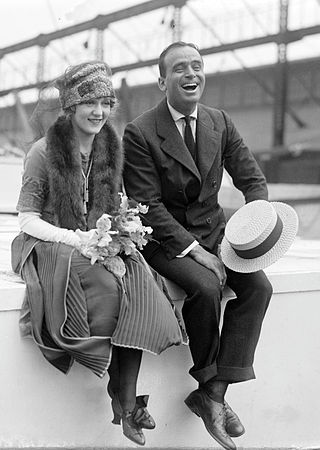
A tobacco pipe, often called simply a pipe, is a device specifically made to smoke tobacco. It comprises a chamber for the tobacco from which a thin hollow stem (shank) emerges, ending in a mouthpiece. Pipes can range from very simple machine-made briar models to highly prized hand-made artisanal implements made by renowned pipemakers, which are often very expensive collector's items. Pipe smoking is the oldest known traditional form of tobacco smoking.

Black tie is a semi-formal Western dress code for evening events, originating in British and American conventions for attire in the 19th century. In British English, the dress code is often referred to synecdochically by its principal element for men, the dinner suit or dinner jacket. In American English, the equivalent term tuxedo is common. The dinner suit is a black, midnight blue or white two- or three-piece suit, distinguished by satin or grosgrain jacket lapels and similar stripes along the outseam of the trousers. It is worn with a white dress shirt with standing or turndown collar and link cuffs, a black bow tie, typically an evening waistcoat or a cummerbund, and black patent leather dress shoes or court pumps. Accessories may include a semi-formal homburg, bowler, or boater hat. For women, an evening gown or other fashionable evening attire may be worn.

Tobacco smoking is the practice of burning tobacco and ingesting the resulting smoke. The smoke may be inhaled, as is done with cigarettes, or simply released from the mouth, as is generally done with pipes and cigars. The practice is believed to have begun as early as 5000–3000 BC in Mesoamerica and South America. Tobacco was introduced to Eurasia in the late 17th century by European colonists, where it followed common trade routes. The practice encountered criticism from its first import into the Western world onwards but embedded itself in certain strata of a number of societies before becoming widespread upon the introduction of automated cigarette-rolling apparatus.

Punk fashion is the clothing, hairstyles, cosmetics, jewellery, and body modifications of the punk counterculture. Punk fashion varies widely, ranging from Vivienne Westwood designs to styles modeled on bands like The Exploited to the dressed-down look of North American hardcore. The distinct social dress of other subcultures and art movements, including glam rock, skinheads, greasers, and mods have influenced punk fashion. Punk fashion has likewise influenced the styles of these groups, as well as those of popular culture. Many punks use clothing as a way of making a statement.

A hookah, shisha, or waterpipe is a single- or multi-stemmed instrument for heating or vaporizing and then smoking either tobacco, flavored tobacco, or sometimes cannabis, hashish and opium. The smoke is passed through a water basin—often glass-based—before inhalation.

A coat typically is an outer garment for the upper body as worn by either gender for warmth or fashion. Coats typically have long sleeves and are open down the front and closing by means of buttons, zippers, hook-and-loop fasteners, toggles, a belt, or a combination of some of these. Other possible features include collars, shoulder straps and hoods.

A suit, lounge suit, or business suit is a set of clothes comprising a suit jacket and trousers of identical textiles worn with a collared dress shirt, necktie, and dress shoes. A skirt suit is similar, but with a matching skirt instead of trousers. It is considered informal wear in Western dress codes. The lounge suit originated in 19th-century Britain as a more casual alternative for sportswear and British country clothing, with roots in early modern Western Europe. After replacing the black frock coat in the early 20th century as regular daywear, a sober one-colored suit became known as a lounge suit.

A blouse is a loose-fitting upper garment that may be worn by workmen, peasants, artists, women, and children. It is typically gathered at the waist or hips so that it hangs loosely ("blouses") over the wearer's body. Today, the word most commonly refers to a girl's or woman's dress shirt, although there is considerable confusion between a true blouse and a women's shirt. It can also refer to a man's shirt if it is a loose-fitting style, though it rarely is. Traditionally, the term has been used to refer to a shirt which blouses out or has an unmistakably feminine appearance, although even many "standard" shirts today have a somewhat blousy fit, and the numbers of men wearing such shirts may match that of women wearing actual blouses.

Fashion in the 1890s in European and European-influenced countries is characterized by long elegant lines, tall collars, and the rise of sportswear. It was an era of great dress reforms led by the invention of the drop-frame safety bicycle, which allowed women the opportunity to ride bicycles more comfortably, and therefore, created the need for appropriate clothing.

A smoking jacket is an informal men's style of lounge jacket originally intended for tobacco smoking. Designed in the 1850s, a traditional smoking jacket has a shawl collar, turn-up cuffs, and is closed with either toggle or button fastenings, or with a tie belt. It is usually made from velvet and/or silk.

A cocktail dress is a dress suitable at semi-formal occasions, sometimes called cocktail parties, usually in the late afternoon, and usually with accessories.

1840s fashion in European and European-influenced clothing is characterized by a narrow, natural shoulder line following the exaggerated puffed sleeves of the later 1820s and 1830s. The narrower shoulder was accompanied by a lower waistline for both men and women.
A kiseru (煙管) is a Japanese smoking pipe, traditionally used for smoking kizami, a finely shredded tobacco product resembling hair.

Cannabis smoking is the inhalation of smoke or vapor released by heating the flowers, leaves, or extracts of cannabis and releasing the main psychoactive chemical, Δ9-tetrahydrocannabinol (THC), which is absorbed into the bloodstream via the lungs. Archaeological evidence indicates cannabis with high levels of THC was being smoked at least 2,500 years ago. As of 2021, cannabis is the most commonly consumed federally illegal drug in the United States, with 36.4 million people consuming it monthly.

In a decade that broke many traditions, adopted new cultures, and launched a new age of social movements, 1960s fashion had a nonconformist but stylish, trendy touch. Around the middle of the decade, new styles started to emerge from small villages and cities into urban centers, receiving media publicity, influencing haute couture creations of elite designers and the mass-market clothing manufacturers. Examples include the mini skirt, culottes, go-go boots, and more experimental fashions, less often seen on the street, such as curved PVC dresses and other PVC clothes.

Western fashion in the 1920s underwent a modernization. For women, fashion had continued to change away from the extravagant and restrictive styles of the Victorian and Edwardian periods, and towards looser clothing which revealed more of the arms and legs, that had begun at least a decade prior with the rising of hemlines to the ankle and the movement from the S-bend corset to the columnar silhouette of the 1910s. Men also began to wear less formal daily attire and athletic clothing or 'Sportswear' became a part of mainstream fashion for the first time. The 1920s are characterized by two distinct periods of fashion: in the early part of the decade, change was slower, and there was more reluctance to wear the new, revealing popular styles. From 1925, the public more passionately embraced the styles now typically associated with the Roaring Twenties. These styles continued to characterize fashion until the worldwide depression worsened in 1931.

A smoking pipe is used to taste the smoke of a burning substance; most common is a tobacco pipe,. Pipes are commonly made from briar, heather, corn, meerschaum, clay, cherry, glass, porcelain, ebonite and acrylic.

Smoking is a practice in which a substance is combusted and the resulting smoke is typically inhaled to be tasted and absorbed into the bloodstream of a person. Most commonly, the substance used is the dried leaves of the tobacco plant, which have been rolled with a small rectangle of paper into an elongated cylinder called a cigarette. Other forms of smoking include the use of a smoking pipe or a bong.

Depictions of tobacco smoking in art date back at least to the pre-Columbian Maya civilization, where smoking had religious significance. The motif occurred frequently in painting of the 17th-century Dutch Golden Age, in which people of lower social class were often shown smoking pipes. In European art of the 18th and 19th centuries, the social location of people – largely men – shown as smoking tended to vary, but the stigma attached to women who adopted the habit was reflected in some artworks. Art of the 20th century often used the cigar as a status symbol, and parodied images from tobacco advertising, especially of women. Developing health concerns around tobacco smoking also influenced its artistic representation.

Fashion and clothing in the Philippines refers to the way the people of the Philippine society generally dress up at home, at work, travelling and during special occasions.





















